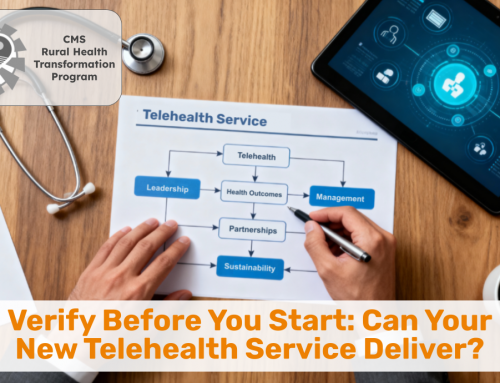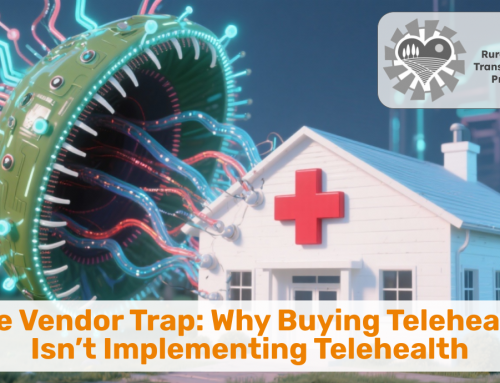The launch goes live. The dashboard lights up. Everyone celebrates.
Six months later, the telehealth service is barely being utilized — and no one notices.
That’s not a tech failure. That’s a systems failure.
The problem is systemic: many leaders treat a “launch” as the finish line. But go-live isn’t proof of success — it’s just the first stress test. If sustainability isn’t built into the foundation, the structure won’t hold, and the service will crumble.
In a previous article, we unpacked why buying telehealth isn’t the same as implementing it. The next layer is this: implementing telehealth isn’t the same as making it stick.
Here are the Seven Ingredients of Sustainable Telehealth that separate high-functioning, enduring telehealth programs from those that fade after the ribbon-cutting.
1. Design With Sustainability From Day One
Sustainability starts with how you frame the program before a single visit takes place. When telehealth is planned purely as a launch project, the structure often lacks long-term anchors. But when sustainability is baked in from the beginning, the program is built with durability, not just deployment, in mind.
How to do it: To build in sustainability from the start, create a strategic case, a financial case, and a clinical case.
A strategic case examines how the telehealth service will support your organization’s strategic objectives — whether that is market share, geographic reach, improved quality measures, or clinician recruitment.
The financial case verifies the path to a positive return on investment (ROI) through reimbursable services, increased revenue, reduced penalties, etc.
The clinical case ensures the buy-in by the clinicians that the telehealth service represents an appropriate practice of medicine.
When your CEO, your CFO, and your CMO are happy about the new telehealth service, you know you have a winner that will stay in place, sustainably.
2. Make the Right Thing the Easy Thing
People don’t resist innovation — they resist friction. Even well-designed programs fail if they’re too hard to use. Long-term success hinges on making telehealth easy, intuitive, and seamlessly usable in everyday scenarios.
How to do it: Consciously design workflows optimized for telehealth. Select a vendor not based on IT’s assessment of ease of integration, but based on clinicians’ and patient representatives’ assessment of the ease of use. Streamline scheduling and access. Use single sign-on, reduce clicks, and ensure every role understands their part in the process. Build training and support into onboarding, not just the go-live period. Solicit real-time feedback from users and fix barriers quickly.
When it’s easy to do the right thing, clinicians, staff, and patients naturally adopt and retain telehealth as part of how care gets done. Simplicity is the single biggest predictor of sustained use.
3. Don’t Bolt It On — Build It In
When telehealth exists as a parallel process — new tools, different systems, extra steps— it becomes fragile and optional. Sustainability depends on making telehealth feel like a natural extension of how care is delivered, not a side project.
How to do it: Map workflows end to end, and intentionally integrate telehealth into scheduling, documentation, clinical roles, billing, and reporting. Align telehealth protocols and policies with existing policies. Use familiar systems — don’t require new logins or platforms if the existing tech stack can support it.
When done right, telehealth isn’t something staff have to remember to do — it’s just how care gets delivered in appropriate cases. Integration reduces friction, reinforces use, and supports long-term adoption.



4. Validate Assumptions With a Proof of Concept
Most pilots are built to show feasibility. A strong proof of concept is built to test proof the value and to set things up for sustainability. It exposes the cracks before you scale — verifying that clinical workflows function, patients engage, and key metrics hold up under real-world conditions.
How to do it: Define what you’re trying to learn, not just what you’re trying to prove. Identify assumptions about patient demand, provider adoption, and operational cost. Create simple, trackable KPIs tied to those assumptions. Run the proof in live environments — not a test lane—so you capture operational realities.
Using a proof-of-concept approach helps you reduce the risk of public failure, increase confidence in the solution through social proof, and are able to scale what works — based on evidence, not excitement. You are also building your catalog of KPIs for ongoing performance management.
5. Assign Operational Ownership—Daily, Not Just Strategic
Sustainability demands stewardship. Too many programs lose momentum because the launch team moves on, and no one takes over daily operations. Clear, ongoing ownership ensures that the program doesn’t become an orphaned initiative.
How to do it: Assign a performance leader and a performance coordinator, jointly responsible for telehealth operations. Have this team monitor performance, resolve daily issues, and connect the dots between strategy and execution. It can’t be “everyone’s job,” or it will become no one’s.
When done right, issues get addressed before they snowball, improvements get implemented faster, and accountability drives long-term continuity. Ownership makes the program visible, manageable, and enduring.
6. Operationalize PDCA as Culture, Not Compliance
No solution is ever so perfect that it cannot benefit from continuous improvement. The Plan-Do-Check-Act (PDCA) cycle isn’t just a process to follow — it’s a mindset shift. Most teams “Plan-Do” effectively. Fewer teams systematically “Check,” and even fewer truly “Act” in a structured way. When PDCA becomes a cultural norm, programs evolve and improve instead of plateauing.
How to do it: Make the regular application (and completion) of PDCA cycles a leadership accountability. Establish regular cycles of performance review and adaptation. During “Check,” don’t just evaluate results — also check whether the telehealth process is still being followed, or if workarounds have crept in. In the “Act” phase, assign someone to own each process adjustment — and track it.
With a regular application of PDCA, you turn telehealth into a living, evolving, improving system — not a static protocol. Continuous improvement makes the program more resilient to change and more valuable over time.
7. Review Telehealth Performance Like Everything Else
If telehealth data lives on a separate dashboard — or worse, doesn’t get reviewed at all — it will remain disconnected from core operations. Real sustainability comes when telehealth performance is managed as part of enterprise performance.
How to do it: Incorporate telehealth KPIs into routine quality, access, and utilization reporting. Include telehealth metrics in management reviews, huddles, and board updates. Track trends over time and compare against benchmarks — both internal and external.
With attention on performance telehealth becomes part of how the organization leads and manages care — not a side note. This reinforces its legitimacy and protects it during budget or strategy shifts.
Ensuring Sustainability
The launch is the illusion. Sustainability is the outcome.
If your telehealth program doesn’t have structural support for ownership, integration, improvement, and ease — then it’s not sustainable. It’s just temporarily active.
Here’s the hard truth: most health systems have no defined framework for long-term telehealth sustainability.
They invest in a go-live, not a go-glide approach.
That’s why programs stall and all but disappear — not because the idea was wrong, but because the design was incomplete.
You don’t need more technology. You need more intentional design.
The question isn’t “Did we launch?” It’s: “Did we build something that deserves to last?”
To launch is not enough. The work that makes telehealth sustainable is the work most organizations skip.
This article includes thoughts and ideas from my long-term collaborator Kathy Letendre. Check out her related article “To Launch is Not Enough”.








To receive articles like these in your Inbox every week, you can subscribe to Christian’s Telehealth Tuesday Newsletter.
Christian Milaster and his team optimize Telehealth Services for health systems and physician practices. Christian is the Founder and President of Ingenium Digital Health Advisors where he and his expert consortium partner with healthcare leaders to enable the delivery of extraordinary care.
Contact Christian by phone or text at 657-464-3648, via email, or video chat.






